Stand up for the facts!
Our only agenda is to publish the truth so you can be an informed participant in democracy.
We need your help.
I would like to contribute
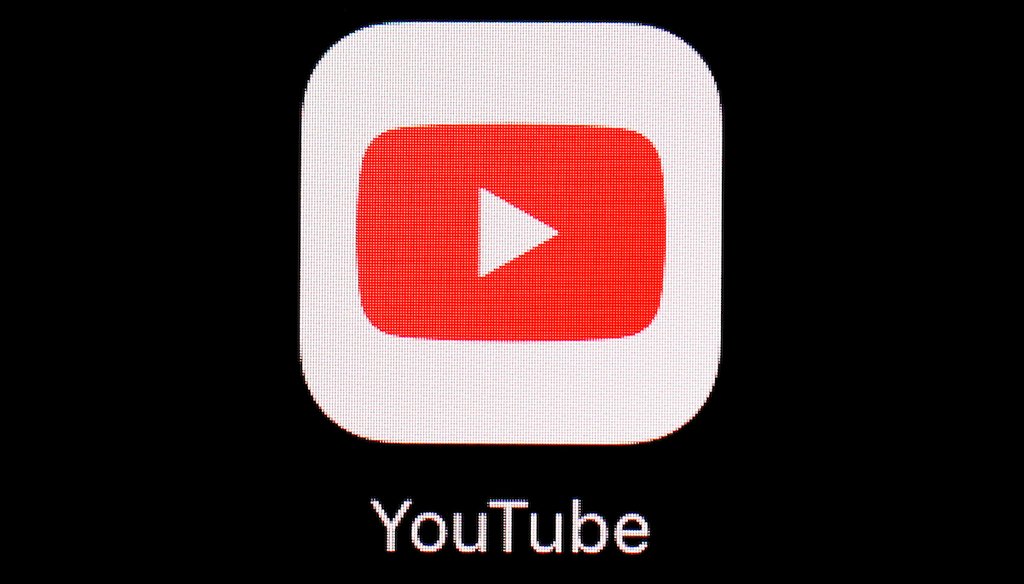
The YouTube app on an iPad in Baltimore on March 20, 2018. (AP)
If Your Time is short
-
Doomsday prepper Patrick Humphrey’s YouTube channel has rapidly increased its audience by regularly publishing false or misleading videos that stoke fear of wide-scale disaster. A year ago, he had 6,000 subscribers; now, he has 91,000, and his videos have been viewed nearly 18 million times.
-
Experts say this type of content goes viral because it communicates a possible threat, which elicits an emotional response from viewers.
-
Humphrey’s YouTube channel is monetized and he sells access to exclusive video content, suggesting that his prolific posting is financially motivated.
According to YouTuber Patrick Humphrey, the country is collapsing and everyone needs to prepare. His online account chronicled a summer filled with cascading calamities.
He claimed "two massive explosions on U.S. critical infrastructure" on July 26 caused power outages. He said July 29 that in an official statement, the White House had urged people to brace "for something big to happen, potentially to our critical infrastructure." On Aug. 7, Humphrey alleged the federal government had declared a "major food shortage emergency" in six states.
But when PolitiFact took a closer look into Humphrey’s claims, we rated each one False. We found no large explosions, no warning about an imminent attack and no food shortage declared.
Nearly every week, Humphrey posts new videos that stoke fear of impending disaster or claim that a catastrophe has already happened, a tactic linked to doomsday prepping that has rapidly increased his audience. As of late August, he had more than 91,000 YouTube subscribers, a significant increase from the 6,000-subscriber milestone he celebrated just one year ago.
Humphey’s videos employ a misinformation tactic experts say is common: He refers to real events, but sensationalizes and presents them without important context, which misleads viewers or pushes them toward false conclusions. His videos also have been shared across other social media sites such as TikTok and Facebook, amplifying his reach and contributing to the spread of the misinformation. Efforts to reach Humphrey via email addresses listed on his YouTube channel and the contact page of his website were unsuccessful.
Misinformation strategies
Humphrey, once a farming content creator, now spreads falsehoods using a consistent pattern. First, he makes an inflammatory claim about an emergency or a warning — often beginning with the YouTube video’s title or thumbnail image.
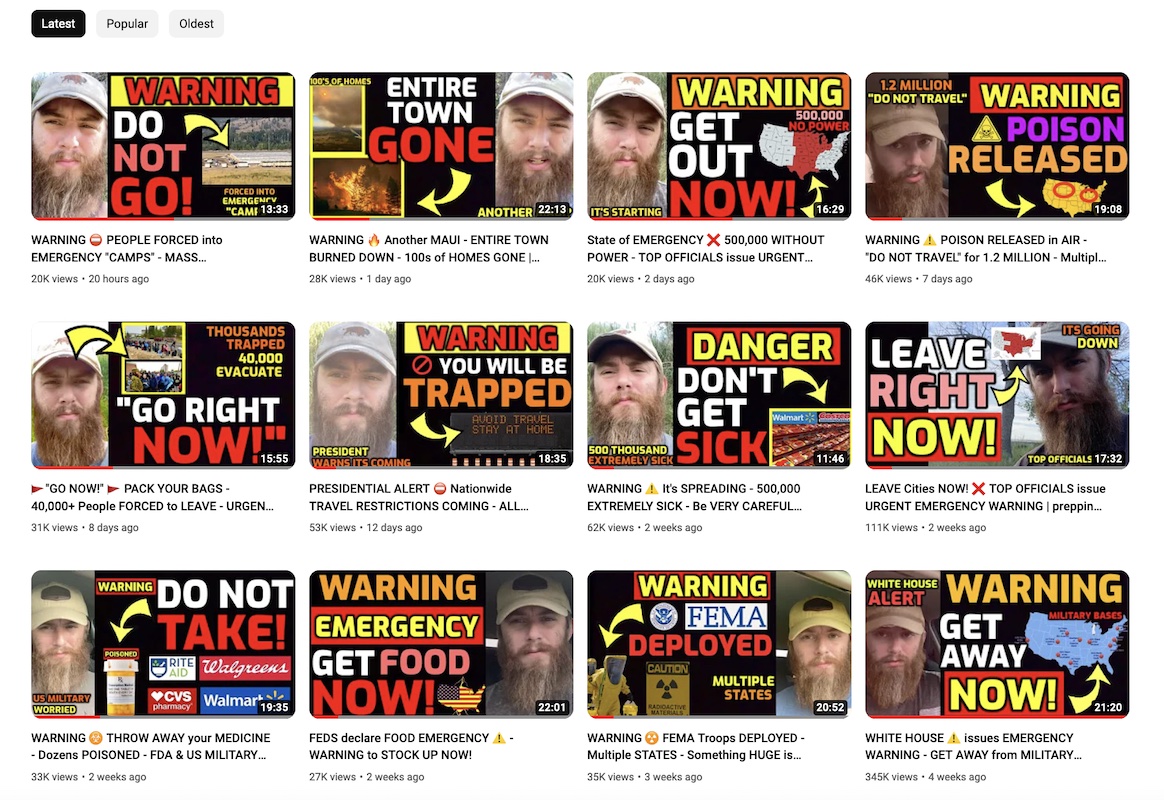
(Screenshot from YouTube.)
When the videos begin, Humphrey’s first words radiate urgency.
"Something big is happening right now. This is big breaking news," he said in an Aug. 20 video. "We have over a million people right now that are under emergency travel restrictions — emergency travel restrictions, and this is due to poison being released into the air."
Fatima Gaw, a Northwestern University doctoral student who studies disinformation networks and political influencers, said that presenting content as breaking news is an attention-grabbing technique.
He "not only emphasizes the supposed incoming crisis but makes it sound ‘urgent,’ something people purportedly should act on before it is too late," she said of Humphrey.
In Humphrey’s most recent videos, while repeating alarming claims, he often says he’ll "get into all the details." Then, within a few minutes, he shows screenshots of news stories or press releases and reads excerpts from them. The sources are often well-known news organizations or federal agencies.
But closer examination shows that Humphrey is using the information selectively and misleadingly.
In the Aug. 20 video — in which he refers to "emergency travel restrictions" — he reads from a Yahoo News article about an ozone Air Quality Alert in southwest Ohio, including tips for reducing air pollution. The only apparent connection to travel restrictions is the article’s recommendation to "avoid driving if possible." Humphrey says the guidelines are voluntary — but puts air quotes around the word.
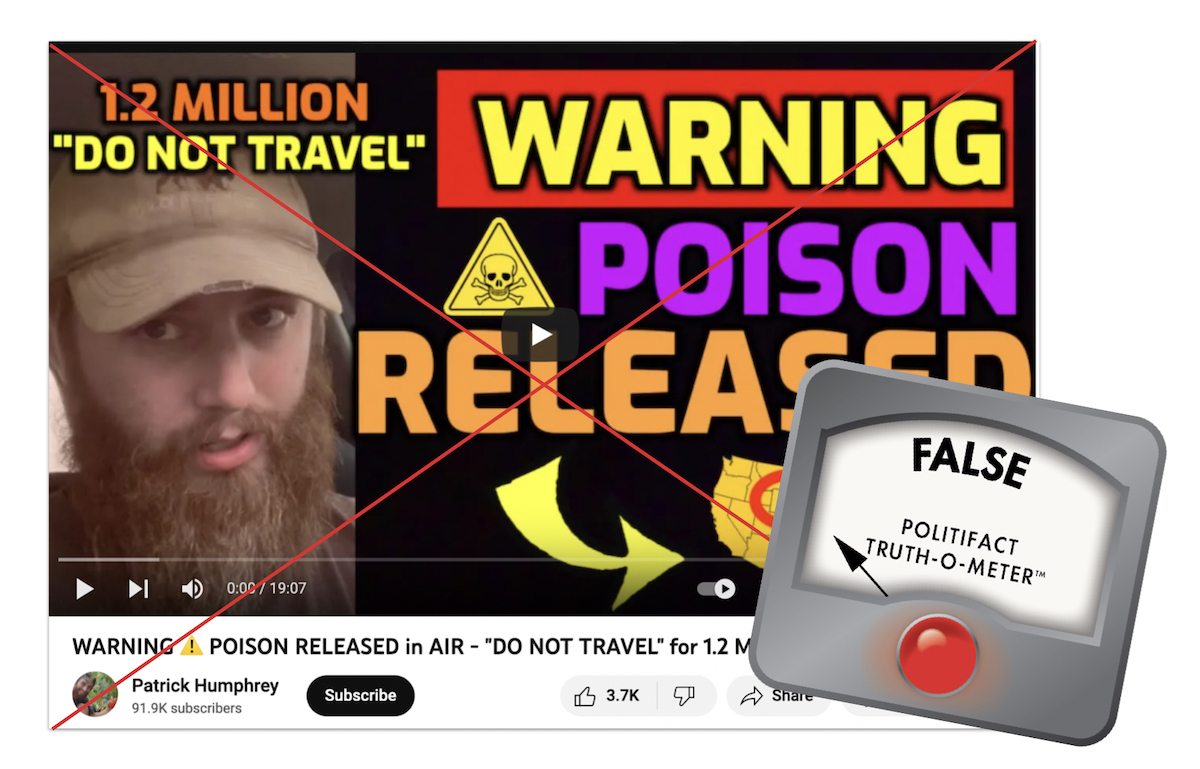
(Screenshot from YouTube.)
Among misinformation producers, this approach — decontextualizing pieces of accurate information, recontextualizing them in misleading ways or drawing causal relationships where none exist — is popular, said Zeve Sanderson, executive director of New York University’s Center for Social Media and Politics. It is often more effective than producing outright false information, such as claiming that an event happened when it didn’t.
Toward the end of Humphrey’s videos, which typically last 10 to 30 minutes, he urges people to stockpile food, fuel and water.
"Keep your tanks filled," Humphrey said in the Aug. 20 video, adding that he lives off the electrical grid in a recreational vehicle with his family. "Get your tanks filled, because energy is key and energy is going to be extremely valuable in the future."
In other videos, he encourages people to get off the grid, buy generators and learn to farm or live off the land — and to subscribe to his YouTube channel and share his videos.
The transition from farming to doomsday prepping
In the past year, Humphrey has posted more than 350 videos. Because he did not respond to PolitiFact’s requests for comment, we cannot be sure what motivates him to post misleading videos so prolifically. But profit is one potential motive.
His YouTube channel is monetized, which means that Humphrey can earn money when people watch his videos.
He joined YouTube in late 2018, according to publicly available statistics. Initially, his channel was about farming. In 2019, Humphrey posted videos about transplanting seedlings and planting tomatoes. His digital footprint suggests he was once based in Florida, but he said in a recent video that he is now living north of Denver.
The older videos, many of which are no longer public, often received only a few hundred views.
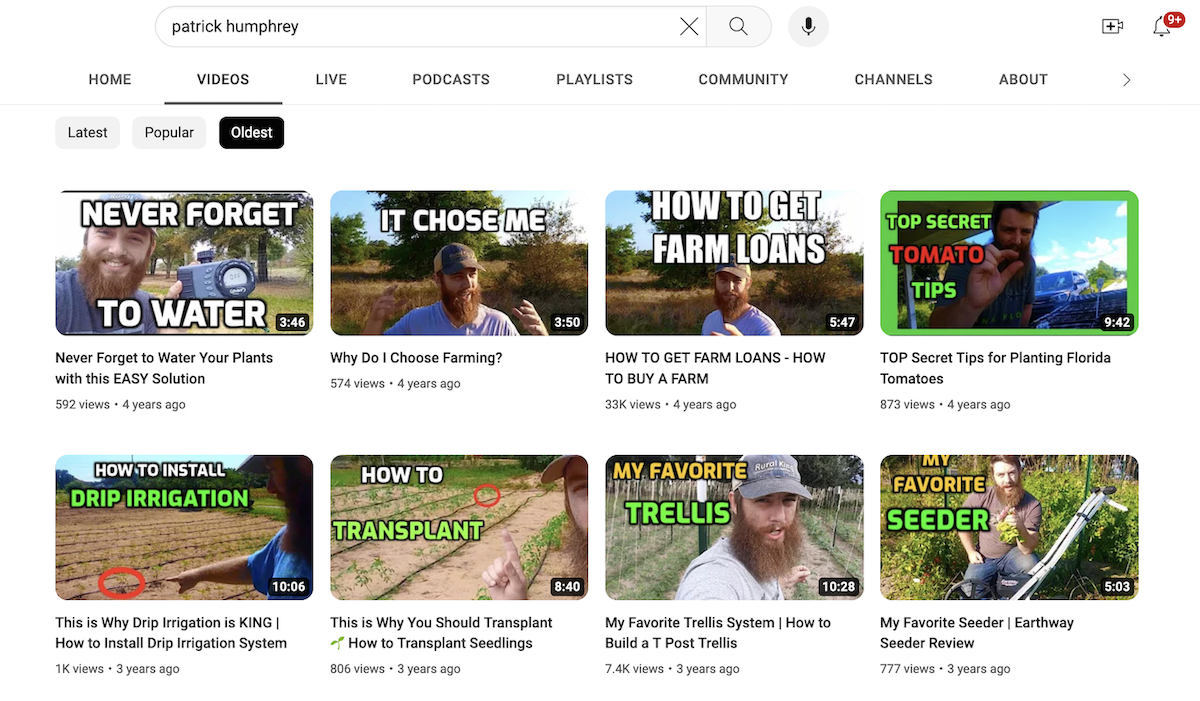
(Screenshot from YouTube.)
In April 2022, Humphrey appeared to switch tactics, transitioning to making videos about emergencies and the need for preparedness. Those videos include phrases such as, "Prep now!" and "SHTF is here!", an acronym for "s- - - hits the fan." It’s shorthand among preppers, the community of people who make extreme preparations for apocalyptic emergencies.
The new style of video often received several thousand views. The most popular prepper video has been viewed more than 700,000 times, and more than 25 of the videos have at least 100,000 views.
Humphrey occasionally refers to his farming background, when encouraging people to be self-sufficient in case society collapses. We’ve seen others with farming backgrounds spread similar misinformation.
Gordon Pennycook, a Cornell University behavioral science professor, said these fear-stoking tactics are common among social media influencers because they are effective.
"This is why you see people, such as Humphrey, sort of mold into these inflammatory types over time," Pennycook said. He suspects the shift happens gradually because people learn "that if you just keep sensationalizing more and more, you will gain more and more attention."
"It starts small and gets big," he said.
In total, Humphrey’s videos have been viewed more than 18 million times, according to publicly available YouTube statistics. On average, YouTubers earn about $18 for every 1,000 views, according to Influencer Marketing Hub.
Humphrey’s recent YouTube videos also link to exclusive video content, which people can pay $8 monthly or $60 annually to access.
"Ninety thousand subscribers isn’t that many, and, you know, $8 a month isn’t that much," Sanderson said. But he said he has seen cases where other influencers appear to be motivated by financial gain, even in cases where the payout was not substantial.
How the content spreads beyond YouTube
There are many reasons content goes viral, but one of the most common reasons is when it evokes emotions, said Erik Nisbet, Northwestern University professor of policy analysis and communication and director of the Center for Communication & Public Policy. People are evolutionarily programmed to respond to fear and anxiety, he said.
"When humans are exposed to information that communicates danger, warning, a possible threat, you know, that activates our emotional response that we’re going to pay more attention to it," he said. Humphrey’s content preys on this instinct, Nisbet said, and some social media users might share it to show their friends they are informed and aware of the possible threats.
"We share it in our networks online, because we think it makes us look good in some way," Nisbet said. "It makes us look authoritative."
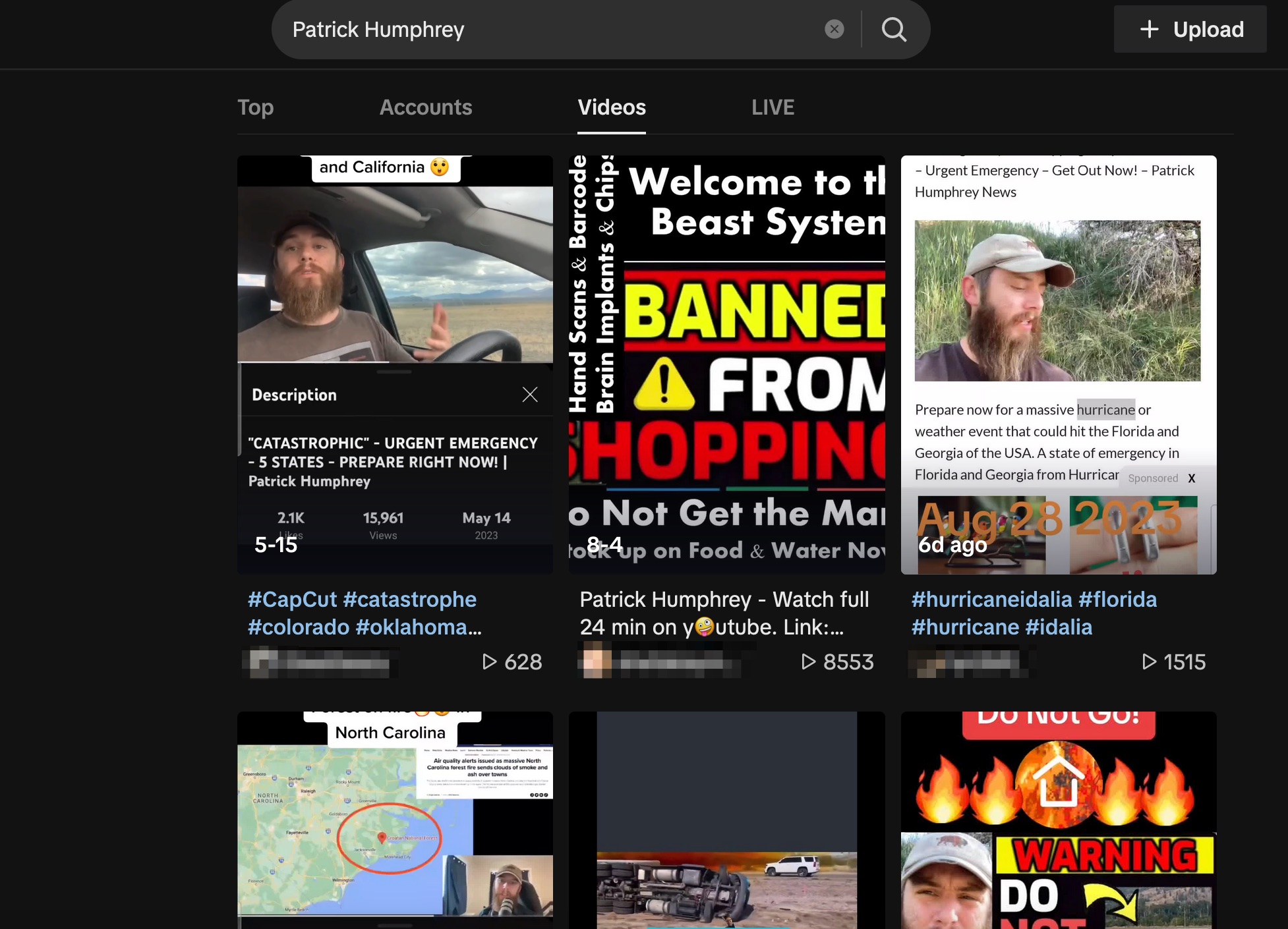
Search results for Humphrey's name on TikTok show that his content has been posted on that platform as well. (Screenshot from TikTok.)
Humphrey’s approach might also help him skirt disinformation regulations online.
Most of the major social media platforms have policies that discourage people from saying or sharing things that are provably false, Sanderson said. But when it comes to drawing a causal relationship between two events despite a lack of evidence, "platforms have seemed to take a lighter moderation hand when it comes to that."
YouTube says it removes "misleading or deceptive content that poses a serious risk of egregious harm."
Before sharing or believing content, Pennycook said people should question whether someone is trying to take advantage of them by making claims about alleged disasters that seem unsupported evidence.
"Think about how the person who is getting you riled up is profiting from it," he said.
PolitiFact Researcher Caryn Baird contributed to this report.
Our Sources
Interview with Zeve Sanderson, executive director of New York University’s Center for Social Media and Politics, Aug. 15, 2023
Interview with Erik Nisbet, Northwestern University professor of policy analysis and communication and director of the Center for Communication & Public Policy, Aug. 16, 2023
Email interview with Fatima Gaw, a doctoral student who studies disinformation networks and political influencers in Southeast Asia, Aug. 19, 2023
Email interview with Gordon Pennycook, a Cornell University behavioral science professor, Aug. 18, 2023
Email exchange with Ethan Porter, professor of political science and media and public affairs at George Washington University, Aug. 17, 2023
Email exchange with Bradley Garrett, a photographer and writer who wrote a book on the prepper community, Aug. 17, 2023
Email interview with Nathaniel Barr, professor of creativity and creative thinking at Sheridan College, Aug. 22, 2023
Patrick Humphrey’s YouTube channel, accessed Aug. 21, 2023
Internet Archive, Sustainable Seasons, archived May 24, 2022
Internet Archive, Sustainable Seasons, archived June 24, 2021
Internet Archive, Sustainable Seasons, archived Nov. 24, 2020
Sustainable Seasons Instagram, accessed Aug. 10, 2023
Sustainable Seasons Instagram post, Feb. 3, 2019
HumReport, Sign Up, accessed Aug. 10, 2023
YouTube @PatrickHumphrey. source code, accessed Aug. 10, 2023
Is this Channel Monetized, The channel "Patrick Humphrey" is monetized!, Aug. 10, 2023
Sustainable Seasons Farm Facebook page, accessed Aug. 10, 2023
YouTube, This is Why You Should Transplant 🌱 How to Transplant Seedlings, Sept. 26, 2019
YouTube, TOP Secret Tips for Planting Florida Tomatoes, Aug 16, 2019
YouTube, This is Why Drip Irrigation is KING | How to Install Drip Irrigation System, Sept. 17, 2019
LinkedIn, Patrick Humphrey, accessed Aug. 10, 2023
Survival Kompass, What is SHTF – Meaning, Examples and an extensive Explanation, June 3, 2023
Patrick Humphrey on TikTok, accessed Aug. 10, 2023
PolitiFact, Video of former CIA director is not proof that government is spraying sky with chemicals, April 20, 2023
PolitiFact, No, ‘two massive explosions’ haven’t taken out US critical infrastructure, Aug. 7, 2023
PolitiFact, The White House did not issue ‘official’ warning about imminent attack to critical infrastructure, Aug. 2, 2023
PolitiFact, ‘Unhealthy’ air quality affected 127 million in June, not August, Aug. 8, 2023
PolitiFact, US did not issue a ‘food shortage emergency’ declaration, Aug. 16, 2023
PolitiFact, Millions weren’t ‘under emergency travel restrictions’ on air quality alert days, Aug. 31, 2023
Off The Grid with Doug and Stacy, accessed Aug. 10, 2023
Influencer Marketing Hub, How Much do YouTubers Make? – A YouTuber’s Pocket Guide [Calculator], March 29, 2023
Yahoo News, Forecast for temperatures in the 80s prompts issuing of ozone Air Quality Alert for Sunday, Aug. 18, 2023
Patrick Humphrey’s YouTube community post, accessed Aug. 21, 2023
YouTube, How does YouTube address misinformation? accessed Aug. 21, 2023
Nature, The psychological drivers of misinformation belief and its resistance to correction, Jan. 12, 2022
Oxford Internet Institute, New research uncovers how misinformation groups make money online, Jan. 19, 2023
The New York Times, Even Conspiracy Theorists Are Alarmed by What They’ve Seen, Aug. 4, 2023
The New York Times, From Doomsday Preppers to Doomsday Plotters, June 7, 2021
Psychiatry Online, Why Humans Are Vulnerable to Conspiracy Theories, July 24, 2020
Frontiers in Psychology, Doomsday Prepping During the COVID-19 Pandemic, April 14, 2021
PolitiFact, Case study: How Facebook pages exploit Russia’s war in Ukraine with false videos, July 27, 2022
Off Grid with Doug and Stacy post, April 14, 2023
The Intercept, The Future Dystopic Hellscape Is Upon Us, July 5, 2021
Meta, Trends in the Diffusion of Misinformation on Social Media, October 2018
The New Yorker, What Drives Doomsday Preppers, Nov. 13, 2018
Patrick Humphrey’s Rumble account, accessed Aug. 28, 2023
TikTok search results for "Patrick Humphrey," accessed Aug. 28, 2023
University of Southern California, USC study reveals the key reason why fake news spreads on social media, Jan. 17, 2023
CBS News, Preppers in 2022: Stocking up and skilling up for extreme catastrophes, Nov. 6, 2022
Patrick Humphrey’s YouTube channel, Warning Poison Released In Air - "Do Not Travel" For 1.2 Million - Multiple States, Aug. 20, 2023


































